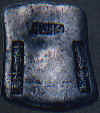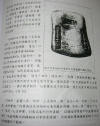Yi Ho , Jardine and the 13 Firms in Canton ─ 怡和行商、怡和洋行與廣州十三行
Weight: 10 taels
Date: 1824 A.D.
Inscriptions: 怡和/道光四年/十月大隆
Yi Ho (Name of a firm)
The 4th Year of Tao Kuang
The 10th Month, Da Lung (Silver bank)
Notes:
Collection of Chang Huei Hsin
Original Introduction from Chang Huei Hsin
According to Mr. Chang, "Yi Ho" was the Chinese name of the famous British company Jardine, Matheson & Co., Ltd., which was a major participant in the import-export business of Kuangtung during the Tao Kuang period. (the company is still trading under the Jardine's name). This piece was cast under its consignment, and unlike other Kuangtung Square Troughs having a stamp of place name on top, Jardine's Chinese name was used instead.
Comments from Otto Lam at 06/11/2004
I am a research student in Hong Kong studying early banking history of China. I tried to get some input from the Kwangtung sycee on your website but find out some errors.
On item Kt10/4 : Yi Ho 10 Taels the 4th year of Tao Kuang. The description
mentioned that the sycee belonged to "Jardine Matheson". Please note that this
information is incorrect as Jardine only used Yee Ho as their Chinese name after
the first Opium War. In fact, the name Yee Ho should be a name for one of the
Hong merchants in China during that period. This merchant traded extensively
with Jardines. Therefore, it was believed that Jardine picked up this name when
the Hong merchant was no longer in the business after the Opium War.
Comments from Stephen Tai, a citation from his
book "A Study on Square Troughs of the Southern Provinces During the Ching
Dynasty" published in 2003.06
...... The 13 Firms in Canton arose
early in the Kangsi period (1662-1722), in response to an imperial government
requirement that foreign merchants had to comply an agency system when dealing
with the Kuangtung Maritime Customs. However, the golden era of the 13 firms didn't arrive
until the 22nd year of Chien Lung (1757), when the imperial government
closed the maritime customs in Fujien, Chekiang, and Jiangsu. Kuangtung,
therefore, became the only legitimate port for foreign trades in China. At that
time, the 13 firms were authorized by the government to collect customs tax from
foreign merchants, and control the distributions of the imported goods to the
domestic markets, and the supplies of the exported goods to the foreign
merchants. The 13 firms' businesses soon extended into opium, silk, tea,
cotton, salt, railway construction, and real estates in the major
cities of China, such as Shanghai and Tienjing, which made them one of the major
economic powers in the Ching Dynasty.
During the Jia Ching and Tao Kuang era (1796-1820, 1821-1850), there was a type of Kuangtung Square Trough which looked similar to those tax silver but lack an inscription of "place name", and a firm's name was inscribed instead. This sycee was related to the business activities of the 13 firms.
The owners of the 13 firms, according to information available to us which dates from the 16th year of Jia Ching (1811) were:
盧廣利 (Lu Kuang Li) for 廣利行 (Kuang Li Firm)
潘同文 (Pam Tong Wen) for 同孚行 (Tong Fu Firm)
伍怡和 (Wu Yi Ho) for 怡和行 (Yi Ho Firm)
葉大觀堂 (Yeh Da Kuang Tang) for 義成行 (Yi Cheng Firm)
and 劉東生 (Liu Dong Shen), 潘麗泉 (Pam Li Chuan), 謝東裕 (Hsieh Dong Yu), 梁天寶(Liang Tien Bao), 麥同泰 (Mai Tong Tai), 李萬源 (Li Wan Yuan), 關福隆 (Guang Fu Lung), 黎西成 (Li Hsi Cheng), was each an owner of their respective firm; their names are the only information we have to identify their businesses, no other infromation is available.
怡和行 (Yi Ho Firm) was the
initial leader of the 13 firms, but 伍浩官 (Wu Hao Guan), the 3rd son of its founder
伍怡和
(Wu Yi Ho) and the leader of the Yi Ho Firm in the early Tao Kuang
period, was the key person who led the business to a glorious
success. Hao Guan started representing Jardine Matheson & Co., Ltd in the 12th
year of Tao Kuang (1832), and as a result, the Chinese people got used to
calling this foreign company as "怡和洋行"(Yi
Ho Foreign Firm). These two firms soon dominated the opium business in
the coastal provinces of China and although it brought them a tremendous fortune, it
also triggered the Opium War later in 1840.
The Wu firm's businesses were progressive and greatly diversified; it even had extensive investments in the US security market and speculated in construction of America's railroads. In the 14th year of Tao Kuang (1834), astonished at the fortune of such a traditional Chinese merchant, the Wall Street Journal reported that Hao Guan- the leader of the 13 firms- was not just a rich Cantonese merchant , but one of the wealthiest in the world. During the Opium War, Hao Guan and his son acted as middle man between the Sino-Anglo negotiations.
There are currently two surviving examples "嘉慶八年.怡和.五月敦和"(The 8th Year of Jia Ching, Yi Ho, The 5th Month, Dun Ho-Name of the smith) and "道光八年.怡和.十月大隆"(The 8th Year of Tao Kuang, Yi Ho, The 10th Month, Da Lung-Name of the smith) found inscribed 怡和 (Yi Ho), but both of them are assumed cast under the consignment of Yi Ho Firm, (rather than Jardine, or Yi Ho Foreign Firm). Also, there is a "道光十九年.廣利.七月祥豐"(The 19th Year of Tao Kuang, Kuang Li, The 7th Month, Hsiang Feng-Name of the smith) which is assumed to be cast under the consignment of another member of the 13 firms-廣利行 (Kuang Li Firm)....
Return to Sycee Talks


